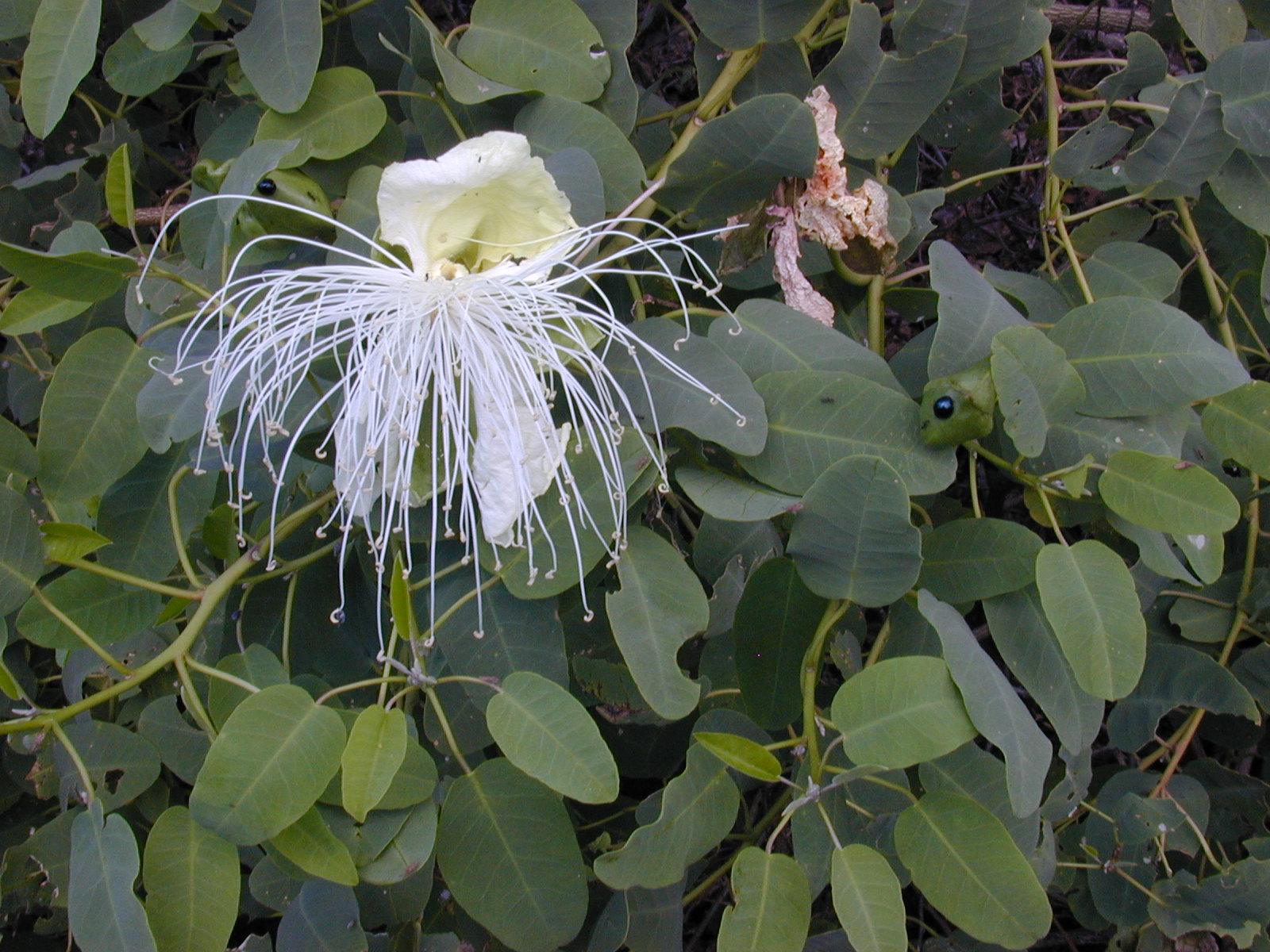- Capparis
:"Capparis" is also a family name, see e.g.
Melpomene Capparis ."taxobox
image_caption = Native Caper or "pua pilo", "Capparis sandwichiana "
regnum =Plantae
unranked_divisio =Angiosperms
unranked_classis =Eudicots
unranked_ordo =Rosids
ordo =Brassicales
familia =Capparaceae
genus = "Capparis"
subdivision_ranks =Species
subdivision = Many, see text|"Capparis" is a
plant genus in the familyCapparaceae which is included in theBrassicaceae in the unrevisedAPG II system . These plants are shrubs or lianas and are collectively known as caper shrubs or caperbushes. "Capparis" species occur over a wide range ofhabitat in thesubtropical andtropical zones.Uses and ecology
Caperbushes are mainly used by humans for their fruit, which are rich in
micronutrients . "C. spinosa", simply known ascaper , yields fruit and more importantly flower buds, which are widely usedpickle d as a vegetable condiment. The fruit of otherspecies , such as "karir " ("C. decidua"), are also used for cooking; "C. mitchellii" and theWild passionfruit (the localsubspecies of "C. spinosa") are well-knownbush tucker inAustralia .Mabinlang seeds ("C. masaikai") are eaten as sweets.Mabinlang is also used in
Traditional Chinese Medicine . "Aspalathos", the root of a shrub contained for example in the sacredAncient Egypt ianincense "kp.t" (kyphi ), is sometimes considered to be "C. spinosa". Other species have also recorded uses inherbalism andfolk medicine ; dedicated research is largely lacking however.Mabinlin s are sweet-tastingprotein s found in Mabinlang seed (and possibly in other "Capparis" species); at least one of them is highly resistant to heat. The market for mabinlins is presently not large, but this is mainly due to insufficient supply rather than to lack of demand.Caperbushes from
arid regions - chiefly "C. decidua" - are highly useful inlandscape gardening ,afforestation andreforestation . They can stopsoil erosion and preserve agricultural land. Any large-flowered species can be used to attractbutterflies . TheCrimson Rose ("Atrophaneura hector"), a spectacularswallowtail butterfly ofSouth Asia , likes to visit flowers of "C. spinosa" in the winter months for example.The fruit and seeds of caperbushes are relished by many
bird s and other animals such asspiny-tailed lizard s. "Capparis" plants are highly important as food for certainLepidoptera caterpillar s, many of themColotini orPierini :
* "Appias lyncida " (Chocolate Albatross) - recorded on "C. heyneana" and "C. roxburghii"
* "Astraptes fulgerator " (Two-barred Flasher) - recorded on "C. frondosa" [Hébert "et al." (2004), Brower "et al." (2006)]
* "Belenois aurota " (Caper White or Pioneer) - recorded on "C. zeylanica"
* "Cepora nerissa " (Common Gull) - mainly on "C. zeylanica"
* "Hebomoia glaucippe " (Great Orangetip) - recorded on "C. monii", "C. roxburghii" and "C. "sepiaria""
* "Ixias marianne " (White Orangetip) - recorded on "C. grandis"Verify source|date=December 2007
* "Leptosia nina " (Psyche) - recorded on "C. zeylanica" and others
* "Pareronia ceylonica " (Dark Wanderer) - recorded on "C. heyneana"Verify source|date=December 2007
* "Pareronia valeria " (Common Wanderer) - recorded on "C. zeylanica"Verify source|date=December 2007The
plant pathogen icascomycete fungus "Mycosphaerella capparis " was described from a caperbush. Some species of "Capparis" are becoming rare, mainly due tohabitat destruction , and a few are seriously threatened withextinct ion.elected species
* "
Capparis arborea " (F.Muell.) Maiden –Brush Caper
* "Capparis baducca "
* "Capparis crotonantha "
* "Capparis cynophallophora " –Jamaican Caper
* "Capparis decidua " (= "C. aphylla") – "karir " ("kirir", "k(h)air", "karril", etc)
* "Capparis discolor "
* "Capparis fascicularis " DC.
** "Capparis fascicularis" var. "fascicularis"
* "Capparis flexuosa " L. –Limber Caper
* "Capparis frondosa "
* "Capparis grandis "
* "Capparis hastata "
* "Capparis heterophylla "
* "Capparis heyneana "
* "Capparis humistrata " (F.Muell.) F.Muell.
* "Capparis indica "
* "Capparis lasiantha " R.Br. ex DC.
* "Capparis lucida " (DC.) R.Br. ex Benth.
* "Capparis masaikai " –Mabinlang
* "Capparis micracantha "
* "Capparis mirifica "
* "Capparis mitchellii " – "wild orange " (Australia), "merne atwakeye" (Arrernte)
* "Capparis mollicella "
* "Capparis monii "
* "Capparis nobilis " (Endl.) F.Muell. ex Benth.
* "Capparis ornans " F.Muell. ex Benth.
* "Capparis pachyphylla "
* "Capparis panamensis "
* "Capparis prisca "
* "Capparis pyrifolia " –Pea-leaved Caper
* "Capparis roxburghii "
* "Capparis sandwichiana " –Native Caper , "maiapiloVerify source|date=December 2007 , pua pilo" (Hawaiian)
* "Capparis sepiaria " L. – acryptic species complex
** "Capparis sepiaria" var. "citrifolia" (Lam.) Tölken
** "Capparis sepiaria" var. "subglabra" (Oliv.) De Wolf
* "Capparis shanesiana " F.Muell.
* "Capparis spinosa " –Caper
** "Capparis spinosa" ssp. "nummularia" –Wild passionfruit , "merne arrutnenge" (Arrernte)
* "Capparis sprucei "
* "Capparis thozetiana " (F.Muell.) F.Muell.
* "Capparis tomentosa " Lam.
* "Capparis uniflora "
* "Capparis zeylandica " L. (= "C. linearis" Blanco) – "kapchip " (Wayuunaiki)Formerly placed here
* "
Boscia oleoides " (as "Capparis oleoides")ee also
*
Caparica (Almada) Footnotes
www.kapari.com
References
* (2006): Problems with DNA barcodes for species delimitation: ‘ten species’ of "Astraptes fulgerator" reassessed (Lepidoptera: Hesperiidae). "Systematics and Biodiversity" 4(2): 127–132. doi|10.1017/S147720000500191X [http://www.bolinfonet.org/pdf/Brower_2006SYSTBIODIVERSITY%5B1%5D.pdf PDF fulltext]
* (2004): Ten species in one: DNA barcoding reveals cryptic species in the semitropical skipper butterfly "Astraptes fulgerator". "PNAS " 101(41): 14812-14817. doi|10.1073/pnas.0406166101 [http://www.pnas.org/cgi/reprint/101/41/14812.pdf PDF fulltext] [http://www.pnas.org/cgi/content/full/0406166101/DC1 Supporting Appendices]
Wikimedia Foundation. 2010.
